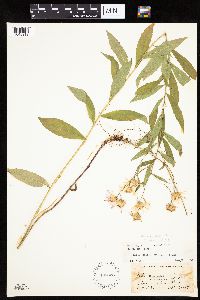Oclemena x blakei
|
|
|
|
Family: Asteraceae
[Aster x blakei (Porter) House] |
Plants 35-65 cm (forming clones; rhizomes subsuperficial, elongate, becoming woody). Stems 1, erect, strict, thin to stout (1.5-3 mm diam.), villosulous, ± glandular distally. Leaves 20-40, equally dispersed, proximal often withering by flowering; sessile; blades oblanceolate to oblong, 20-80 × 4-16 mm, only slightly reduced distally, bases cuneate, margins flat to slightly revolute, slightly to coarsely serrate, scabrous to ciliate, teeth minute or small and acuminate, apices acute, abaxial faces scabrous, adaxial pilose and ± glandular. Heads 2-35+ in corymbiform arrays, seldom borne singly, branches ascending, at ± acute angles with stems. Peduncles 2.5-7 cm, densely villosulous; bracts 2-5, linear, villosulous. Involucres 6.2-8 mm. Phyllaries linear-lanceolate to linear, sparsely villosulous, sometimes glabrescent, seldom sparsely gland-dotted. Ray florets 8-20; corollas white to pink, 12.5-16.5 × 0.8-1.6 mm. Disc florets 10-26; corollas ampliate, 6.1-6.2 mm, glabrous; tubes shorter than very narrowly campanulate throats, strigillose, lobes slightly reflexed, 0.5-1 mm. Cypselae tan, fusiform-obconic, ± compressed, 1.9 mm, ribs 5-8, faces glabrous, ± densely gland-dotted; pappi of pinkish to whitish bristles in 3 series, about ± equal to disc corollas. 2n = 18. Flowering late Jul-Oct. Forest-bog ecotones, shrubby bogs with spruce, larch, Spiraea, Myrica gale, or Ilex mucronata, sometimes shrubby edges of lakes or creeks; 0-700 m; N.B., Nfld. and Labr. (Nfld.), N.S., Ont., P.E.I., Que.; Conn., Maine, Mass., N.H., N.J., N.Y., R.I., Vt. Oclemena ×blakei is the widespread, frequent, mostly F 1 hybrid between O. acuminata and O. nemoralis, which has been confirmed by morphologic, chemical (R. B. Pike 1970; L. M. Hill and O. M. Rogers 1970, 1973; L. Brouillet and J.-P. Simon 1981), and isozyme data (Brouillet and Simon 1980). Hybrid populations also often include backcrosses to both parents as well as later generation hybrids and introgressed parental individuals. Hybrid clones may survive in areas where neither parent is found today. Some reports of this hybrid are misidentified Eurybia radula, which it superficially resembles.
Hybrid of nos. 54 [Aster acuminatus Michx.] and 56 [Aster nemoralis Aiton], but sometimes at least briefly self- perpetuating; lvs thin or a little thickish, elliptic or lance-oblong, slightly toothed, acute or acuminate, tapering to a sessile or subsessile base, 25-40 below the infl, the largest ones 7-24 mm wide; 2n=18. Bogs and moist woods; Nf., Que., and N.S. to N.Y. and N.J. Gleason, Henry A. & Cronquist, Arthur J. 1991. Manual of vascular plants of northeastern United States and adjacent Canada. lxxv + 910 pp. ©The New York Botanical Garden. All rights reserved. Used by permission. |












